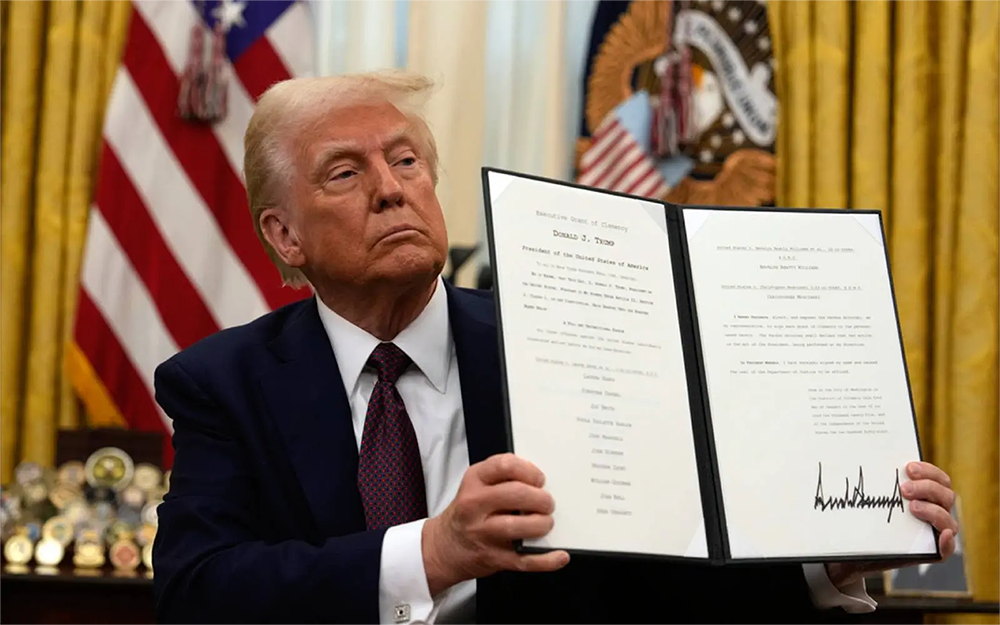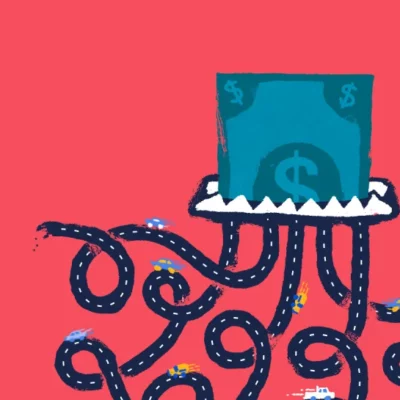
Unflooding the zone: What do the Trump administration’s latest actions signal for transportation?

Federal funding recipients across the country are dealing with uncertainty, delays, and outright cuts to obligated funding. Our updated analysis of disbursements at risk finds that over $20 billion for projects currently underway across the country might be eliminated, according to new memos introduced by Secretary Duffy’s DOT. But don’t feel overwhelmed. We’ve got the information you need.
*THE LATEST: USDOT is expected to move forward with transportation funding freezes as soon as this week*
It’s been a frenetic start to President Trump’s second term in office, and transportation funding and policy has already played a much more significant role than it did during his first. While we covered much of this in our last blog on the impact of the new administration’s Executive Orders, let’s recap all that has occurred to bring you up to speed.
Three things you need to know:
-
A sweeping rollback of electrification, climate resilience, and equity-focused infrastructure policies – The Trump administration’s executive orders have set out to dismantle DEI and equity-related initiatives, environmental justice efforts, and climate programs established during previous administrations. This includes firing staff and removing resources, freezing funds from key infrastructure programs like the National Electric Vehicle Infrastructure (NEVI) Program, and even halting technical assistance programs like the USDOT Reconnecting Communities Institute. Over $20 billion in project funding is at risk.
-
Funding freeze confusion continues unabated despite rescissions – The broad and haphazard language in President Trump’s executive orders and memos from the OMB has led to widespread uncertainty among federal agencies, states, and grant recipients. Despite a temporary restraining order from a federal judge, the administration has continued to push its policy objectives, and we expect their funding freezes to continue without judicial authorization or legal justification.
-
Time is running out for billions of dollars in project funding – USDOT Secretary Sean Duffy’s two recent memos outline a dramatic shift in how Trump’s USDOT will prioritize funding, with plans to eliminate programs related “in any way” to “climate change, ‘greenhouse gas’ emissions, racial equity, gender identity, “diversity, equity, and inclusion” goals, environmental justice, or the Justice 40 Initiative.” Other policy objectives to prioritize families, user-pay models, and benefit-cost analysis remain ill-defined and murky. Crucially, USDOT’s new memos set a timeline for the elimination of all agency policies, funding agreements, and programs by February 18, 2025.
Why is this serious? How much is at stake?
Despite the two standing court orders to halt the funding freeze, the Trump administration’s federal agencies are still refusing to disburse funding for obligated awards. Violating a judge’s order is clearly illegal, but that has not stopped the administration as of yet.
The Trump administration and USDOT are ignoring a temporary restraining order from a federal judge and continuing to assert their authority to pause disbursements and new obligations at their discretion.
Instead of evaluating actual waste, of which there is a great deal in the transportation sector, staff are systematically evaluating individual grants, not according to their performance and ability to move the nation toward its measures of success, but if keywords in their titles and descriptions might trigger reviewers.
As the administration’s intentions to undo progress on policies, programs, and projects come into focus, we took a look at the billions of dollars in funding at stake in congressional districts across the country.
Our analysis has found that more than $20 billion could be at risk, based on what “references or relates in any way” to concepts anathema to the new administration.
The administration is indicating that they could take this action even if a grant agreement (which is basically a contract) has been signed and even where a project sponsor has spent money assuming they would be reimbursed under that grant agreement.
What kind of projects would fit the bill?
Who knows? While all of the administration’s actions have been dramatic, none has been clear or specific. It could mean all projects funded under the “Carbon Reduction Program,” including road work in Indiana and modernized lighting in Arizona, have funding halted. It could mean an end to rural transit operating assistance for tribal communities in Idaho. It could mean senior transit projects focused on equitably serving their communities get cut. It could mean that states that voted for President Trump lose out on nearly $7 billion in owed funding disbursements that were approved on a bipartisan basis. It could mean projects under the National Highway Performance Program that have an element of something that USDOT finds offensive.
In addition to spending analysis by state, we also mapped congressional-level spending data based on our analysis of funding that could be at risk of cancellation due to new memos implementing President Trump's executive orders. Explore this map and see how funding could be affected across the country.
What you can do:
Congress’ constitutional power to make decisions over funding is at stake. The Infrastructure Investment and Jobs Act, though flawed, passed on a bipartisan basis and is distributing benefits across the country that may be undone by the new administration.
- Ask your state and local officials what they plan to do without certain streams of federal funding. Share the data about the project and program funding at risk with them. We split funding information down to the state, county, and congressional district levels in our analysis of funding at risk.
- Make sure your Congressional delegation is aware of the risk to your project and ask what they can do. If you meet with them in person or by phone, that is better than a letter. If you want to also write a letter, see below.
Can’t find your district? Funding might be coming to your community through statewide awards, which are labeled as a congressional district ending in 90.
Make your representative aware of the risk to the project in your community.
Send a letter to your representatives
Trump Transportation Timeline
What’s in USDOT Secretary Duffy’s day-one memos?
1) The “Woke Rescission” Memo
- Orders, in accordance with the EOs outlined above, “to identify and eliminate all orders, directives, rules, regulations, notices, guidance documents, funding agreements, programs, and policy statements, or portions thereof, which were authorized, adopted, or approved between noon on January 20, 2021 and noon on January 20, 2025, and which reference or relate in any way to climate change, "greenhouse gas" emissions, racial equity, gender identity, "diversity, equity, and inclusion" goals, environmental justice, or the Justice 40 Initiative.”
- Within 10 days, all DOT Operating Administrations (such as FHWA, FTA, NHTSA, FRA, etc.) and the Office of the Secretary of Transportation (OST) must identify and develop a report on all DOT “orders, directives, rules, regulations, notices, guidance documents, funding agreements, programs, and policy statements” relevant to the EOs.
- Within 10 days of the report (20 days after the January 29 memo), all operating agencies and the OST shall “initiate all lawful actions necessary to rescind, cancel, revoke, and terminate all DOT orders, directives, rules, regulations, notices, guidance documents, funding agreements, programs, policy statements, or portions thereof, which are subject to the relevant executive orders and which are not required by clear and express statutory language.
Considering the Trump administration’s current broad interpretation of its legal authority to control funding obligations, we found that billions in federal funding for existing projects could be at risk based on their relationship with the previous administration's priorities under the bipartisan Infrastructure Investment and Jobs Act. Nearly $7 billion for existing projects would be at risk in states that voted for President Trump in the 2024 elections.
2) Lowering Costs Through Smarter Policies, Not Political Ideologies Memo
This new policy memo updates standards for policies, programs, and activities to “maintain reliance on rigorous economic analysis and positive cost-benefit calculations,” setting forth the following policy principles:
- USDOT grantmaking, lending, policymaking, and rulemaking shall be “based on sound economic principles and analysis supported by rigorous cost-benefit requirements and data-driven decisions.”
- Grants, loans, policies, and rules must have benefits that outweigh costs. While the EPA updates estimates of the social cost of carbon, the methods used to estimate the value of changes in greenhouse gas emissions from agency actions are reverted to guidance issued in 2003.
- Focus on minimizing costs and maximizing benefits to families and communities.
- Asserts that DOT-supported programs or activities (including grants and loans) shall not be used to further local political objectives or projects that “are purely local in nature and unrelated to a proper Federal interest.” [“Local in nature” or a “proper Federal interest” is undefined.)
- USDOT should support projects and goals that:
- Utilize user-pay models. [This is not defined but could refer to anything from congestion pricing, road tolling, to having EVs pay into the Highway Trust Fund. This was mentioned in the Mandate for Leadership’s Department of Transportation section. However, President Trump has voiced opposition to congestion pricing.
- Direct funding to local opportunity zones.
- Mitigate impacts on families and family-specific difficulties, and give preference to communities with “marriage and birth rates higher than the national average, (including in administering the Federal Transit Administration’s Capital Investment Grant program).
- Recipients of DOT support or assistance are prohibited from imposing vaccine and mask mandates. [It is unclear if this applies to past, existing, or future mandates. All 50 states and the District of Columbia have one form of vaccine mandate or another, particularly for public school students. In terms of mask mandates, there are no statewide mandates currently.]
- Require local compliance and cooperation with Federal immigration enforcement and “other goals and objectives” specified by the President and Secretary.
- Finally, this memo directs USDOT to update all Notices of Funding Opportunities, grant agreements, loan agreements, and program documents, etc. to comply with this memo. [Updating open funding opportunities at the beginning of a new administration is common.]
What's happened so far and, when?
January 20, 2025:
- President Trump signs the following executive orders:
- These EOs sought to undo environmental justice, climate, equity, and electrification-focused Executive Orders made during the Biden administration and Civil Rights Act-era equity Executive Orders dating back to President Johnson in the 1960s.
- Federal employees whose work relates to Diversity, Equity, and Inclusion have been placed on leave, and web pages on accessibility and whistleblowing have been removed. We anticipate even more employees and resources will be targeted in the coming weeks.
- The EO 14154: Unleashing American Energy singles out the Infrastructure Investment and Jobs Act’s electric vehicle charging infrastructure grant programs to pause the disbursement of funds, but due to imprecise wording, the order paused all funding from the Infrastructure Investment and Jobs Act and Inflation Reduction Act programs.
- These Executive Orders are significant and have been referenced in memos from the Office of Management and Budget (OMB) and the United States Department of Transportation (USDOT). These memos call for identifying and eliminating funding agreements and programs that were out of line with the policy outlined in these orders.
January 21, 2025:
- OMB released a new memo, M-25-11, to “clarify” the scope of EO 14154: Unleashing American Energy. However, the memo references a section in the EO that was unclear about which specific programs or policies the administration meant to cut.
- This memo effectively paused all new obligations to existing, appropriated programs, including the National Electric Vehicle Infrastructure (NEVI) Program, the Charging and Fueling Infrastructure (CFI), and even technical assistance provided under the Thriving Communities Program and Reconnecting Communities Institute was halted.
- This has led to uncertainty among existing federal funding recipients and announced discretionary grant awardees. As a result, some states, such as Alabama and Oklahoma, have paused work on the NEVI program.
January 27, 2025:
- Late in the evening, OMB circulated the M-25-13 memo to all agencies, calling for a pause in all federal disbursements, profoundly confusing federal employees, Members of Congress, and recipients of federal funds and services from the federal government.
January 28, 2025:
- OMB sent agencies an expansive spreadsheet in a PDF to grade every federal assistance listing (including defunct ones), requiring unspecified employees in the federal bureaucracy to justify the work conducted under specific programs and ensure they were not advancing equity, climate mitigation, or anything amongst a list of policies the Trump administration objects to.
- Harvard’s Environmental & Energy Law Program wrote a great summary of the legal mechanisms available to the administration and the risks different kinds of program funds may face due to the memo.
January 29, 2025:
- Amidst significant confusion about the implications, objections from Congress’s majority, and one looming court-ordered pause out of two parallel legal cases (in the federal courts of the District of Columbia and Rhode Island), the Trump administration’s OMB pulled the funding rescission memo.
- However, comments from White House Press Secretary Leavitt and other actions from the administration demonstrated that they would continue to pursue the end goals of the memo through agency actions.
- These actions included a stop-work order for the Road to Zero Coalition, which funds safety efforts from seat belt use and truck safety to police enforcement and safety education. It was launched under the Obama Administration and continued through the first Trump Administration and the Biden Administration.
- USDOT Memos: Following Secretary Sean Duffy’s confirmation to lead USDOT, the agency released two policy memos with potentially far-reaching implications for projects underway today and how the agency will approach projects during the administration.
January 31, 2025:
- The Rhode Island federal judges overseeing a suit brought forward by 22 states and DC issued a temporary restraining order to force an end to the administration’s funding freeze.
- However, agency-issued stop orders were not lifted and new ones were put in place.
February 3, 2025:
- The Department of Justice responds to the Rhode Island Judge’s Temporary Restraining Order and asserts that the executive branch has the authority to continue implementing the Executive Orders outlined above. The Trump administration continues to direct agencies to halt disbursements and the obligation of funding that goes against the administration’s new policy objectives.
What might happen next?
Based on the memos and timelines set forth by inaugural executive orders, the following dates may be of importance going forward.
February 6, 2025:
- New unelected and unappointed political operatives in USDOT are expected to begin identifying specific programs, policies, and projects for elimination following the memos issued by Sec. Duffy on his first day in office.
February 8, 2025:
- USDOT will submit a written report identifying all policies, funding agreements, programs, etc., that conflict with the President’s broad executive orders. This deadline was set by the “Woke Rescission” memo.
- Within 10 days of the submission of this report, the USDOT will initiate all lawful actions necessary to rescind, cancel, revoke, and terminate all USDOT funding agreements, policies, guidances, etc, out of line with Trump administration policies and executive orders.
- Considering the administration’s interpretation of what is lawful, it is unclear to what extent active projects with obligated funding and authorized programs are at risk.
February 18, 2025:
- February 18 marks the deadline for the elimination of USDOT funding agreements, policies, guidances, etc., that are out of line with Trump administration policies and executive orders, per the “Woke Rescission” memo.
April 20, 2025:
- This date marks 90 days of the temporary freeze initially announced on January 20. This date was not referenced in OMB memo M-25-13 or in policy memos released by USDOT. There is no indication that this would be the end of any planned pause for funding disbursement or obligation.



